Boxes and Markings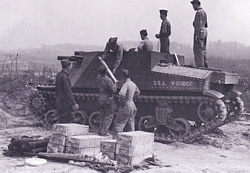 The
first 105mm howitzer packaging was two rounds in M39 fiber containers packed into
a wooden box measuring 38-1/4 x 12-11/16 x 6-15/16 inches. Little is known about
the original two-round box but what is known indicates that it was essentially
the same as the later "long" end-opening version. Pictured at right,
from Hunnicutt's Sherman, is the T32 prototype of the M7 howitzer undergoing
testing at Fort Knox in February 1942. The initial two-round boxes, secured with
three steel bands, can be seen. The diamond-shaped washers are evident on the
end caps. The open ends face the vehicle, and the discarded end pieces are on
the viewer's side of the boxes. The
first 105mm howitzer packaging was two rounds in M39 fiber containers packed into
a wooden box measuring 38-1/4 x 12-11/16 x 6-15/16 inches. Little is known about
the original two-round box but what is known indicates that it was essentially
the same as the later "long" end-opening version. Pictured at right,
from Hunnicutt's Sherman, is the T32 prototype of the M7 howitzer undergoing
testing at Fort Knox in February 1942. The initial two-round boxes, secured with
three steel bands, can be seen. The diamond-shaped washers are evident on the
end caps. The open ends face the vehicle, and the discarded end pieces are on
the viewer's side of the boxes.
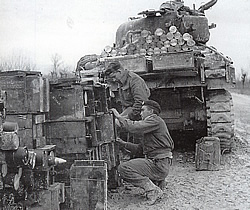 This
initial long box was replaced by the three-round bundle in April 1941. "Short"
two-round boxes (23-23/32 x 11-5/8 x 11-5/8 inches) were used on an expedient
basis in the summer of 1943 but they were replaced by "long" two-round
boxes (37-1/4 x 12-1/8 x 7 inches) in January 1944. Few details on the construction
or configuration of the short box are available. At left is an October 1944 photo
of the short boxes. The boxes look to be end-opening, but do not have tie rods.
The removable ends have a different construction from the long boxes as well.
The AIC (Ammunition Identification Code) on the left is R1QCC, meaning an M1 HE
w/TSQ M54, packed one shell per container M129; and one cartridge case per container
M130, two containers each for each round, four containers to the short box. The
AIC in middle is a puzzle. It is R1Q _ _. However, the last letter does not appear
to be one that indicates a short box (C or U), so it could be a packing that did
not last long in the supply system. This
initial long box was replaced by the three-round bundle in April 1941. "Short"
two-round boxes (23-23/32 x 11-5/8 x 11-5/8 inches) were used on an expedient
basis in the summer of 1943 but they were replaced by "long" two-round
boxes (37-1/4 x 12-1/8 x 7 inches) in January 1944. Few details on the construction
or configuration of the short box are available. At left is an October 1944 photo
of the short boxes. The boxes look to be end-opening, but do not have tie rods.
The removable ends have a different construction from the long boxes as well.
The AIC (Ammunition Identification Code) on the left is R1QCC, meaning an M1 HE
w/TSQ M54, packed one shell per container M129; and one cartridge case per container
M130, two containers each for each round, four containers to the short box. The
AIC in middle is a puzzle. It is R1Q _ _. However, the last letter does not appear
to be one that indicates a short box (C or U), so it could be a packing that did
not last long in the supply system.
The
T18 canister round used some type of “short” two-round box, measuring
19-5/8 x 13 x 7-3/4 inches. From the dimensions it does not appear that the containers
were stacked two-over-two. 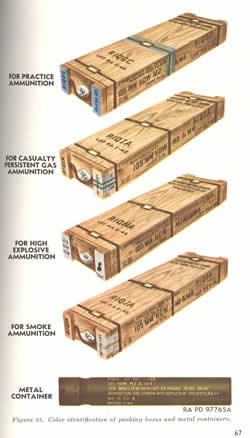 Throughout
the WWII period the long two-round boxes were the "end opening" type
with one fixed end and one removable end. (See illustrations.) The loose end was
held closed with a wing nut and diamond-shaped washer on a tie bolt that ran through
the box. Both ends had cleats and rope handles. The top and bottom were flat,
nailed shut, and reinforced with steel banding. A close examination of the illustration
reveals that the removable end was slightly smaller than the box's cross-section
while the fixed end was the same size. The removable piece also had a second board
that nested within the four sides. This helped secure the end in place. Throughout
the WWII period the long two-round boxes were the "end opening" type
with one fixed end and one removable end. (See illustrations.) The loose end was
held closed with a wing nut and diamond-shaped washer on a tie bolt that ran through
the box. Both ends had cleats and rope handles. The top and bottom were flat,
nailed shut, and reinforced with steel banding. A close examination of the illustration
reveals that the removable end was slightly smaller than the box's cross-section
while the fixed end was the same size. The removable piece also had a second board
that nested within the four sides. This helped secure the end in place.
The
black and white illustration below shows a long two-round box and the markings
applied to it. Of note is the AIC. These five-character codes provided a quick
and easy way to identify the details of a particular type of ammunition, including
the weapon that used it, the projectile, the fuzing, and the packaging. In fact,
the AIC was the primary method used to requisition ammunition until the introduction
of Federal Stock Numbers in the 1950s. All of the M2, M2A1, and M4 105mm howitzer
ammunition was coded R1Q _ _ or R1U _ _ . In the 1945 ammunition catalog there
are 98 different codes for the various types of M2/M2A1/M4 105mm howitzer ammunition
and packagings. The differences were often minute. For example, the M1 105mm howitzer
HE shell was variously coded: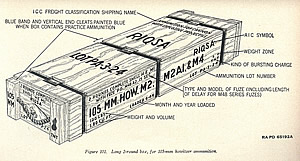 - R1QBA
when loaded with a M48 or M48A2 fuze (.05 sec delay) and packed 1/fiber container,
2 containers/box
- R1QBS
when loaded with a M48 fuze (.05 sec delay) and packed 1/fiber container, 2 containers/box
- R1QDB
when loaded with a M48A1 fuze (.15 sec delay) and packed 1/fiber container, 2
containers/box
- R1QDT
when using a steel case and loaded with a M48A1 fuze (.15 sec delay) and packed
1/fiber container, 2 containers/box
The
AIC system was not adopted until January 1942 so they would not appear on ammunition
packed before that date. Also
noteworthy is the caliber and type of weapon marking. For 105mm howitzers this
changed over the course of the war. At the start it was 105MM HOW M2 &
M2A1. When the M4 was standardized in September 1943, it became 105MM HOW
M2, M2A1, & M4. By 1945 boxes were being produced with 105MM HOW M2A1
& M4 markings. Boxes
were originally unpainted with black stenciling. In March 1943 boxes were ordered
to be painted or stained brown with yellow stenciling (regardless of ammunition
type) but the requirement to color the boxes for artillery ammunition was dropped
in September 1944. Below
is a photo seen in Steve Zaloga's U.S. Armored Artillery in World War II
of the end-opening boxes in Belgium in December, 1944. A close look shows boxes
with the ends removed, a stack of loose ends, M105 fiber tubes with black tape
on one end as well as one with yellow tape on both ends, open boxes with the tie-rod
sticking out, boxes reinforced with two bands rather than three and what looks
to be an M39 container with one fixed cap.
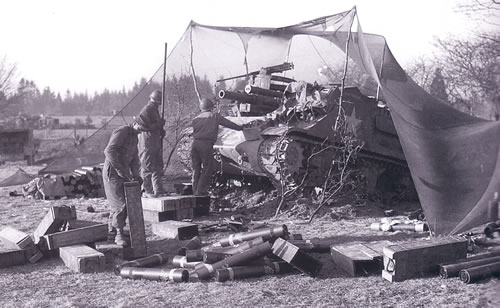
Overview
Ammunition
Fiber
Containers
Cloverleaf Bundles
Boxes
and Markings
Metal Container
Common
Rounds for Modelers
References
105mm
Howitzer Ordnance: Comparison Review of 1/35 Scale Sets
105mm
Howitzer Kits, Upgrades, and Accessories
| 
















